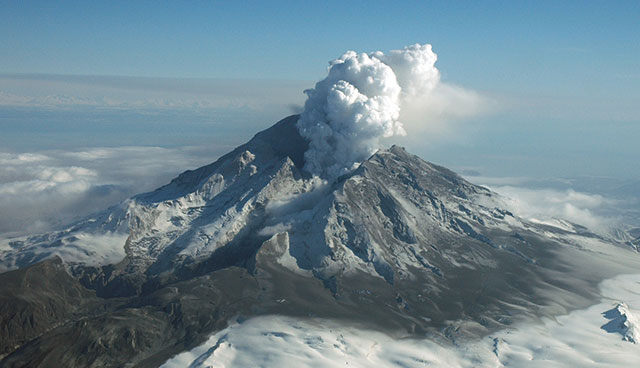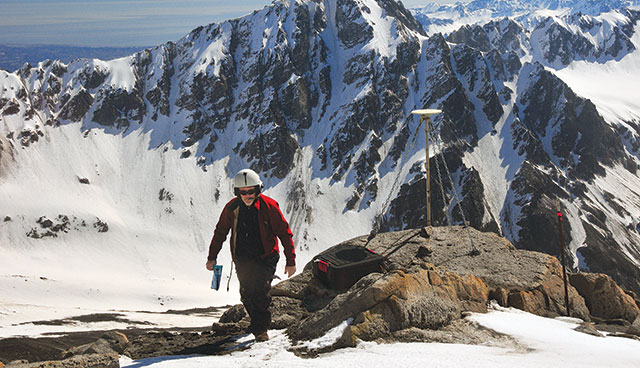Cool Jobs: Volcanologist

Most people flee from erupting volcanoes because they’re big and loud and dangerous. But when a volcano blows its top anywhere in Alaska, Game McGimsey can’t wait to study the lava-and-ash-spewing monster.
“One thing I enjoy about my job is that I can work on something that is actually active,” says McGimsey, a volcanologist with the U.S. Geological Survey’s (USGS) Alaska Volcano Observatory in Anchorage. “We can go to a volcano and see the eruption, the lava flowing, the ash falling. There is an incredible amount of Earth energy involved in volcanic processes.”
Video: Volcanoes Erupting Around the World
Volcanoes by the Numbers
A volcano is a vent at the surface of Earth through which molten rock and gases escape. Most of this activity occurs in the crust, relatively close to the surface, though some well-known volcanoes are fed more deeply by what are known as mantle plumes. (One of the most famous is the Yellowstone Caldera in Wyoming.) There are about 1,500 potentially active volcanoes worldwide, 169 of which are in the United States. Alaska, where McGimsey works, is home to 52 historically active volcanoes (of about 90 potentially active), with the others located in the western states, Hawaii and the Mariana Islands.
Volcanologists study how and why volcanoes form, what makes them erupt and the impact they have on Earth. Most regularly go out into the field to study volcanoes up close. Part of McGimsey’s job involves monitoring Alaska’s many active volcanoes and giving local, state and federal officials a heads-up when a volcano becomes restless and might erupt.
“I prefer this mixed operational/research position rather than just research because I work more closely with the public,” says McGimsey, a longtime Scout leader who gives Scouts tours of the observatory and leads groups to see volcanoes. “A lot of my work has very real-time benefits to people and government agencies.”
An Important Science
Like most careers in the sciences, volcanology requires a lot of education. McGimsey received an undergraduate degree in geology at the University of North Carolina, then landed an internship with a prominent geologist at the USGS whose area of expertise was volcanoes. After earning a graduate degree at the University of Colorado, McGimsey accepted a job with the USGS and has been with the Alaska Volcano Observatory, one of five such monitoring and research facilities in the United States, for 25 years.
The study of volcanoes is important because the majority of the world’s volcanoes are located in heavily populated areas, potentially endangering lives and property if they erupt.
“Volcanoes have been erupting since the Earth formed, and they are going to keep erupting,” McGimsey says.
“The more we know about volcanoes, their processes and the behavior of individual volcanoes, the better situated we are to provide warnings and help get people out of harm’s way.”
Potentially Serious Consequences
Volcanoes can impact the world in ways we might not think about. For example, while a volcano’s trickling lava flow might not pose an immediate threat, huge plumes of gas and ash thrown into the atmosphere can impact air traffic and make the air dangerous to breathe.
This has occurred several times in recent decades. One of the most frightening incidents was on Dec. 15, 1989, when a 747 flew through a massive ash cloud produced by Mount Redoubt, an Alaskan volcano that hadn’t erupted in 25 years. The ash caused all four engines to flame out, and the plane’s electronics went dead.
“They were essentially a heavy glider coming down,” McGimsey says. “The plane was within several thousand feet of crashing into the mountains below when the pilots got a couple of the engines restarted and landed safely in Anchorage.” It cost nearly $80 million to repair the ash damage to the plane.
Such situations show just how dangerous volcanoes can be. However, professional volcanologists are aware of the risks and go to great lengths to protect themselves.
“There is definitely a hazard level to volcanology, more so than some other jobs,” McGimsey admits. “But as a group, volcanologists are very careful. We understand how serious the hazard is, and we don’t like taking unnecessary chances. We avoid venturing too close to an erupting volcano, for instance, because it’s not worth injury or death simply to get a rock or a photograph.”
Volcano Facts
The word “volcano” originates from Vulcan, the Roman god of fire. » Molten rock is known as “magma” when it is inside the Earth and “lava” when it reaches the surface. » In 1883, a volcano on the island of Krakatoa, located between Java and Sumatra in Indonesia, exploded with a force equivalent to 200 megatons of TNT, making it one of the most devastating volcanic eruptions in modern history. Tens of thousands in the region perished, and the blast was heard more than 2,800 miles away. » Lightning is occasionally observed in a volcano’s ash cloud, created by turbulent interaction of ash particles. » At 30,085 feet from ocean-floor base to peak, Mauna Loa in Hawaii is the world’s largest active volcano.
Job Facts: Volcanologist

What to Expect: Volcanologists are geologists who study volcanic processes and the impact that volcanoes have on the regions around them. Some volcanologists work in laboratories, while others visit volcanoes to study them up close.
Job Outlook: Volcanology is an important scientific discipline, but job opportunities are limited. The largest employer of volcanologists is the U.S. Geological Survey, which staffs five volcano observatories in the United States. Volcanologists also work for schools and universities and for science-based organizations such as the Smithsonian Institution.
Education and Experience: Volcanologists who work for the U.S. Geological Survey are expected to have advanced college degrees and lots of study in the field.
Salary: Depending on education, experience and other factors, annual salaries can range from $77,000 to $157,000.
Make Your Own Volcano
What you need
- Baking Soda
- Vinegar
- Dishsoap
- Water
- Cup or volcano model with container in the middle
What you’ll do
1. Scoop two tablespoons of baking soda in the cup.
2. Add three tablespoons of water.
3. Drop in two drops of dish soap.
4. Pour vinegar into the container and watch it erupt!
Baking soda is a base and vinegar is an acid. Combining the two causes a chemical reaction that bubbles and breaks up the liquid into the water while releasing carbon dioxide into the air (which makes the fizzing sound). The dish soap adds extra bubbles.
you have to have atleast a geosccience degree first.